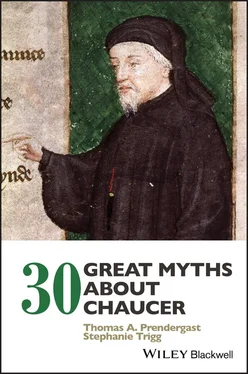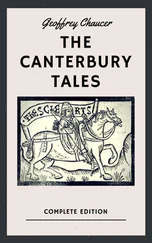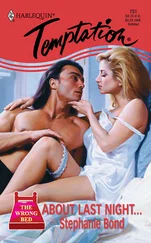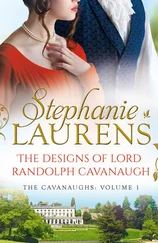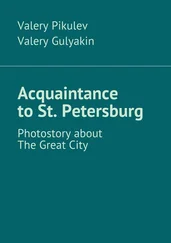Some aspects of popular culture tell a different story, however. Even though Chaucer is associated with the structures and practices of cultural elites that might render him unapproachable to many potential readers, he is a regular and familiar feature in many works of the contemporary medievalist imagination that have a broader cultural reach. He appears as a character in numerous historical fictions, especially in medievalist detective fiction; and in cinematic and television adaptations of the Tales or fictions about the Middle Ages. Equally, there is also a growing number of translations or adaptations of his works (especially the Canterbury Tales ) into rap poetry or modern creole dialects: part of a growing global movement of adaptations and translations. These adaptations have the effect of bringing Chaucer into a closer relationship with contemporary culture, helping to ease the path of modern students to read and follow his language, though of course there are various linguistic and cultural differences that must be negotiated, while some tales and poems are more readily assimilated into contemporary social contexts.
A final contradiction runs through our best efforts to teach Chaucer. Nearly every critical or teaching edition of his works features a phonetic chart or list that indicates the etymological history and pronunciation of his vowel sounds. Another regular feature of such editions is a typically confusing message about the inconsistency and irregularity of Chaucerian orthography. Equally inhibiting to students who may have little or no experience studying grammar or with inflected languages will be a complicated account of the grammatical forms and structures of Middle English. Yet in spite of all this technical information, it is a common feature of many introductory guides or editions designed for classroom use to say something like, “the best way to learn Chaucer’s language is to find a good teacher and learn from them.” 4 Even the Harvard website, under its “Teach Yourself to Read Chaucer’s Middle English,” concedes, “The best way to learn to read Chaucer’s Middle English is to enroll in a course with a good and enthusiastic teacher (as most teachers of Chaucer are).” 5 This is an instruction that sends typically mixed signals to contemporary readers. While we embrace the performative and oral delivery of Chaucer, such advice strains against the growing importance of auto‐didacticism in medieval studies, in a context where the general expectation is that nearly everything can be learned online.
Nevertheless, once readers have accustomed themselves to a few principles – pronounce all the consonants; remember that long “i” and long “a” are pronounced differently; and be aware that the decision of whether or not to pronounce the final ‐e will be contextual and at best uncertain – they can mostly get to the point where they can start to imitate their teacher or the growing number of recordings available online, and perhaps even get a sense of what Middle English might have sounded like. There is also a time‐honored tradition of encouraging students to memorize the famous first eighteen lines of the General Prologue to the Canterbury Tales , as a kind of “rite of passage”: a form of induction into the mysteries of medieval studies that their teachers and professors might also have endured and passed through. Sometimes students are encouraged to come and speak in front of the professor; other teachers orchestrate a “read aloud competition.”
The General Prologue lends itself well to this challenge through its complex syntax and the subordinate clauses leading up to the principal clause. Curiously, this insistence on the efficacy of the spoken word takes us right back to Chaucer’s time, and the reminder that much of his poetry would have been read aloud. Insisting that students read out loud and master Chaucerian pronunciation accelerates their comprehension, but also deepens appreciation of the persistent orality of medieval literature. As we know, medieval texts were not read just in private study; they were shared and recited in small or larger gatherings. Baba Brinkman draws a powerful analogy when he compares the story‐telling competition in the Tales to a competitive rap battle. 6 It reminds us that later medieval poets fought to keep and retain the attention of their audiences by a range of rhetorical means (direct address, exclamations, etc.), as well as the cultivation of strong authorial or narrative personalities.
That said, there are some impediments to the immediate comprehension of Chaucer’s poetry, in addition to the questions of pronunciation, orthography and inflections. The vocabulary is one example. Nearly all readers of Chaucer (academics, teachers and students) need glosses for words that are completely unfamiliar, or that are drawn from technical vocabulary of various kinds, or those whose semantic connotations vary according to changing contexts, as well as those that have different meanings (the famous “false friends” that appear deceptively similar to modern words). It would be a mistake to underestimate the linguistic alterity of Chaucer, but while his language may be becoming further distanced from the varieties of modern English, there are more and more resources available online, such as the literal line‐by‐line translations of many of the Tales available on sites such as Harvard’s The Geoffrey Chaucer Page. With such aids, the language of Chaucer is no more difficult than the complex metaphorical structures of many passages in Shakespeare, for example. As with so many things, “difficulty” is in the eye of the beholder and can always be trumped by the desire to understand. Nevertheless, in an increasingly global culture, teachers and scholars of Chaucer need to acknowledge that there is no simple, “natural” or even single path to familiarity and ease with Chaucer’s language.
1 1John Lane translated the Squire’s Tale into couplets in 1614 (and continued it). See John Lane’s Continuation of Chaucer’s Squire’s Tale, ed. F.J. Furnivall, from the original ms. version of 1616, Douce 170, collated with its ms. revision of 1630, Ashmole 53; with notes “On the magical elements in Chaucer’s ‘Squire’s tale,’” and analogues by W.A. Clouston (London: Kegan Paul, Trench, Trübner & Co, 1888, 1890). In the 1630s, Jonathan Sidnam modernized the first three books of Troilus and Criseyde. Edmund Waller, Poems … upon several Occasions … The third Edition with several Additions … (London: 1668), 234–5.
2 2Joseph Addison, “An Account of the Greatest English Poets, 1694,” in The Works of the Right Honourable Joseph Addison, notes by Richard Hunt, edited by Henry G. Bohn, Bohn’s Standard Library (London: H.G. Bohn 1854–56), 1:23.
3 3James Kinsley , ed., The Poems of John Dryden (Oxford: Oxford University Press, 1958), 4:1457.
4 4See, for example, Robert Boenig and Andrew Taylor , eds., The Canterbury Tales , 2nd edn. (Peterborough: Broadview, 2012), 18; and V.A. Kolve and Glending Olson , eds., Geoffrey Chaucer: The Canterbury Tales , 2nd edn. (New York: W.W. Norton, 2005), xv.
5 5http://sites.fas.harvard.edu/~chaucer/teachslf/less‐0.htm, accessed 7 November 2018.
6 6 https://music.bababrinkman.com/album/the‐rap‐canterbury‐tales, accessed 8 November 2018.
Конец ознакомительного фрагмента.
Текст предоставлен ООО «ЛитРес».
Прочитайте эту книгу целиком, на ЛитРес.
Безопасно оплатить книгу можно банковской картой Visa, MasterCard, Maestro, со счета мобильного телефона, с платежного терминала, в салоне МТС или Связной, через PayPal, WebMoney, Яндекс.Деньги, QIWI Кошелек, бонусными картами или другим удобным Вам способом.
